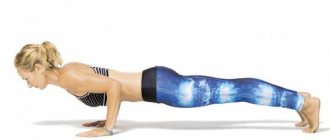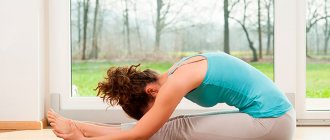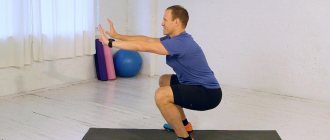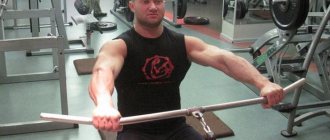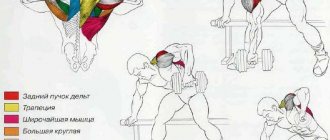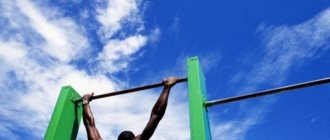Bhujangasana - cobra snake pose
Snake pose is considered one of the main asanas in classical yoga practice. The technique of performing bhujangasana involves lying on your stomach with your body raised up. Support can be on your hands. The face looks at the ceiling or straight ahead. Legs extended along the floor. It is important to connect the movements of the arms and body with breathing cycles. This will make the snake pose even more effective.
The healing power of cobra asana lies in the fact that it is useful for normalizing the secretions of the internal glands, as well as improving the functioning of the kidneys and digestive system. With its help you can eliminate discomfort in the lumbar and thoracic spine. But bhujangasana has its contraindications. This is especially true for those who suffer from thyroid pathologies. They should be extremely careful while performing this exercise.
This asana energizes and gives strength, flexibility and elasticity to muscle tissue. If a person has slipped spinal discs, they can be eliminated with the help of bhujangasana. It also helps with osteochondrosis of the spine. But with hernias, you should be careful and before performing the cobra pose, you should consult an osteopath.
With the help of this asana, digestion improves, since the asana itself is supine, with the person lying on his stomach. Due to this position, internal massage of the organs is achieved, which has a beneficial effect on their functioning. In addition, bhajangasana is also effective for the functioning of the chakras. It helps manipura, svadhisthana, anahata and vishuddha to open up and become more harmonious.
Contraindications for yoga poses
Exclude this asana from practice if you are bothered by:
- back injuries;
- headache;
- carpal tunnel syndrome;
- inguinal hernia;
- acute course of diseases of the abdominal organs;
- acute stages of radiculitis.
Also, the asana cannot be performed during menstruation and pregnancy .
If you find an error, please select a piece of text and press Ctrl+Enter.
Description of the cobra pose
The name itself in translation means the word snake. This is where the description of the asana as a cobra or snake pose comes from. Bhujangasana itself resembles the movements of a snake when it opens its hood in the desire to rush at its prey, or when it becomes alert at the sight of something.
Snake pose is very beneficial for digestion. It is believed to ignite the inner fire and also allow kundalini energy to circulate better. It is also effective for opening and harmonizing a person’s chakras.
Execution step by step
Bhujangasana itself is very easy to perform. The stages of its implementation in the classic version are as follows:
- lie on the floor on your stomach;
- stretch your legs along the floor;
- place your hands under your shoulders and lean on them;
- lift the body up;
- gradually reach as high as possible towards the ceiling;
- throw your head back, reaching the top of your head towards your shoulders;
- make sure that the pubis does not come off the floor;
- strive to stretch your back as much as possible;
- delay in position for about 30 seconds;
- gradual return to a supine position.
The cobra exercise should be performed slowly and without sudden movements. If a person has problems with the spine, he should be very careful not to harm the already damaged spinal discs.
You can repeat the exercise up to 3 times. No more. Its effectiveness depends not on the number of repetitions, but on careful adherence to the exercise technique. Variants of performing ardha bhujangasana can be different.
Execution technique
Step 1:
Lie on your stomach on the floor. Extend your legs back with the entire outer part of your feet, including your toes, on the floor.
Place your hands on the sides of your body, palms on the floor under your shoulders, fingers extended towards your head.
Press your elbows towards your body.
Step 2:
Press the front of your thighs and pubis toward the floor and, as you inhale, begin to lift your head, shoulders, and chest.
When you can no longer lift your upper body using your back muscles alone, begin to straighten your arms to a height where you can keep your pubic area and legs flat on the floor.
Curl your tailbone toward your pubis and lift your pubis toward your navel—this will prevent your lower back from arching. Slightly tighten, but do not squeeze, your buttocks.
Step 3:
Draw your shoulder blades together and down, and push the sides of your ribs forward.
Stretch your chest up and forward, but do not push only your front ribs forward - this promotes arching in the lumbar region.
The goal of cobra pose is to open and stretch the chest.
Feel an even stretch across the entire front of your body.
Step 4:
Hold the pose anywhere for 15 to 30 seconds, breathing easily.
Variations and modifications
In terms of psychological variations, bhujangasana can be performed with or without visualization, and with or without breathing techniques. In this case, if you visualize the thyroid gland or internal organs during the asana, you can improve their functioning.
The most common variations are sphinx pose or ardha bhujangasana, as well as purna bhujangasana, otherwise positioned as a more advanced version of the classic cobra asana.
Bhujangasana in an in-depth version has a better effect on the spine. It works as follows. All the first points of the exercise technique are performed in the same way as in the regular version, but when tilting your head back, you should pull your shoulders and head towards the tailbone as much as possible. The deflection in the spine should be maximum. This option is available only to those people who know how to perform the classic modification without unnecessary stress.
After the asana has ended, you can perform child’s pose and lie down for a while, completely relaxed.
The Sphinx pose is performed in this way: you need to lie on the floor with your stomach, put your forehead on the floor, while turning your feet with the soles up. The forearms should rest completely on the floor, similar to how the sphinx is positioned. The body must be completely relaxed. You can add meditation options or simply breathe using appropriate breathing techniques.
Complication
- Perform the cobra yoga exercise with your feet crossed, then you need to change the crosshairs. Repeat the steps several times. If a practitioner has scoliosis, he will experience different types of discomfort. Then it makes sense to determine which leg, located on top, provides difficulties during training, in order to gradually increase the time for performing this particular position. Such actions will provide a guaranteed therapeutic effect.
- The next complications will be turns: you need to perform the full version of this asana, but when inhaling, turn your body to the right. Then look at the heel of your left limb and hold your breath. When exhaling, you need to return to the original position. Repeat the exercise in different directions for several passes.
- Having reached the final version of the Bhujangasana yoga, move your sternum forward, then try to lift it even higher, bending in your chest. At this moment the skull needs to be moved further back. Watch the voltage distribution. It should spread evenly throughout the body - from the feet to the top of the head.
- Then you can move on to performing other exercises of the Bhujangasana yoga complex.
Advantages and contraindications
Among the significant benefits are the positive effects on the spine and abdominal and back muscles. In addition, snake pose is very useful in yoga for stretching the entire body. It allows you to increase the flexibility of your back and the elasticity of your muscle tissue in a short period of time.
The benefits of the exercise are as follows:
- blood circulation in the spine improves;
- the nutrition of the intervertebral discs and the space between them improves;
- clamps and spasms are relieved;
- lung volume increases;
- pain in the thoracic back and lower back is eliminated;
- deep-lying muscle fibers of the back and abs are restored;
- the muscle frame is strengthened;
- the activity of the thyroid gland is stimulated;
- the impact of stress is reduced and fatigue is reduced.
Also, those people who perform bhujangasana quite often or regularly note that their insomnia has disappeared and they began to behave more calmly. It is important to take precautions and not practice bhujangasana if a person has any contraindications.
Benefit
Bhujangasana, like all other backbends, has a strong therapeutic effect. It gives energy, helps relieve back pain, stooped posture, and also helps cope with depression.
Regular performance of the asana allows you to achieve the following effects:
- increased lung volume;
- increased intra-abdominal pressure;
- strengthening and stretching the abdominal muscles;
- getting rid of spinal problems;
- strengthening and rejuvenating the sympathetic nerves of organs;
- stimulation of the functioning of the thyroid and parathyroid glands, as well as the kidneys and adrenal glands;
- improving the functioning of the gastrointestinal tract;
- prevention of stone formation;
- strengthening the spine and buttocks;
- reducing inflammation of the sciatic nerve;
- improvement in asthma;
- relief from stress and fatigue.
Reference! It is written in the Vedas that Bhujangasana eliminates diseases and awakens Kundalini.
Precautions and contraindications
Bhujangasana is quite simple to perform, but like any other asana, it has its contraindications. Among them are:
- pregnancy period;
- serious pathologies of the spinal column;
- oncological diseases;
- severe respiratory diseases;
- pathologies of the cardiovascular system;
- hyperfunction of the thyroid gland.
As a precaution, it should be said that if there are any disorders of the thyroid gland, you should not throw your head too high or back. The cobra exercise or snake pose actually involves throwing your head back. Therefore, people with thyroid pathology should consult their doctor to avoid possible complications.
The Science of Bhujangasana
Cobra asana is one of those universal yoga asanas that is essential in any practice because it has health-boosting properties.
The asana works on opening the chakras (four out of seven): Visuddhi; Anahata; Manipura; Chadhisthana.
Yoga requires dedication and determination, but also provides a wide range of health benefits and improves a person's quality of life. Most of us are accustomed to various pains caused by our lifestyle, and therefore we try to ignore the discomfort, and if the pain is too noticeable, we take medications.
The asana affects all the muscles of the back and shoulders, helps eliminate muscle tension, and is therefore so effective. It should become part of gymnastics to strengthen the back muscles.
Yoga combines physical and mental disciplines to improve muscle flexibility and body tone, and relieve stress and anxiety. However, many asanas are so simple that even babies and children can do them.
Advice for beginners
In hatha yoga, bhujangasana is quite popular and is considered one of the accessible asanas. In practice, it can be convincingly said that the simplified version can be performed by almost anyone. It does not have a negative effect on the human body if the person follows precautions and does not practice bhujangasana if there are any contraindications.
Important points when performing the asana are the following:
- your palms should be pressed as hard as possible onto the floor;
- pull your shoulders back;
- open your chest;
- throw your head back, trying to reach the top of your head towards your tailbone;
- It is better to place your legs next to each other and try to stretch them further along the floor;
- It is best to squeeze your gluteal muscles.
It is best to lift the body upward by tensing the back muscles. This way they will pump more strongly, and the tension will go away faster. If you experience any discomfort or pain in your back, it is better to stop doing the exercise.
Bhujangasana helps the kundalini energy to move freely along the spine. In order to improve the sphere of influence of bhujangasana on the activity of the chakras, it is necessary to visualize or meditate during practice.
For people with a bad spine, you can start by choosing a sphinx asana for yourself. It is considered a lighter version of the exercise. If a person does not have any pathologies, then you can proceed to either a classical or a complicated modification of bhujangasana.
The most common mistakes that people make at the initial stages of practice:
- the pubic bone is not pressed firmly to the floor;
- the chest is not open enough;
- The head is not thrown back well enough.
In order for the bhujangasana exercise to be effective, the technique should be performed with extreme caution, without missing the slightest moment. Every little detail in the asana has its own meaning.
Adjustment of asanas / control points
- pull your shoulders away from your ears, actively pulling them together with your shoulder blades towards your tailbone;
- pull your chest up and forward more through your back muscles, rather than by straightening and pushing your arms out;
- Abs are critical to preventing lower back injury - actively contract your belly from bottom to top;
- Notice that it is easy to get into the pose by simply arching your lower back, but instead of strengthening and creating a flexible spine, you are tightening it. Take your time - although at first you may not be able to rise high and stretch your chest well and bend in this area, but with practice your flexibility will increase.
- The pubic bone always remains on the floor in Bhujangasana.
Common Mistakes
When performing Bhujangasana, people quite often make mistakes, due to which it not only does not bring sufficient benefits, but can also contribute to injury. The most common mistakes are:
- the chest is not fully opened;
- it is not possible to make a correct and uniform deflection;
- the lower back is overloaded and compressed.
Additional description of Bhujangasana
The Cobra pose is one of the basic ones, being one of the most important, it allows for a wide development of the form. Beginners are offered a short sequence of changing positions within Bhujangasana, like a small cycle of backbends.
Initial phase: place our palms on the floor so that when we raise our torso, our arms will be shoulder-width apart and completely perpendicular to the floor. And now you need to sag in the shoulders as much as possible, while the spine hangs out like a lace. There is no effort, the arms are supported, the whole body is relaxed. The exposure time is a minute or a minute and a half, depending on the duration of the absence of sensations. Ideally, the pubic bone will rest on the floor, but let it be as it turns out: let's say you rest on the upper or even middle part of the thighs. There should be no discomfort in the lower back. It happens that a person, relaxing his back muscles and feeling how his lower back bends, begins to experience unpleasant sensations in it. In this case, you should perform this asana with a tense lower back for some time, gradually the spine will adapt, and the lumbar region will relax and sag without pain.
Having lowered yourself after the necessary endurance and rested, you can put your legs on your legs (foot on foot), crossing your legs, and in this position rise into Bhujangasana . The nuances of execution are the same as in the first deflection, but something has been added, namely: the “leg to leg” position gives the spine an axial twist, and when this asana is performed for the second time, already with a changed position of the legs, then people with scoliosis They definitely feel the difference in sensations, sometimes quite pronounced. So, we have two approaches of one minute each in Bhujangasana , with crossed feet, then changing the position of the legs and resting.
The next element of the sequence is lifting the body without arms, with the help of the back muscles (holding time - up to 20 seconds) and then, with the hands moving forward, without lowering the body, we rise even higher and take the final shape (legs shoulder-width apart), shutter speed - up to 60 seconds. All this time, breathing remains continuous, free and relaxed.
In the last two phases - with crossed legs, it is possible - having risen to the final position, also do Ardha Bhujangasana. This is an interesting point: in one pose we perform another, essentially without changing the position of the torso and without touching the arms at all, except perhaps by adding some amount of physical effort to them. This is done like this: when, having risen to the final form of the “cobra pose”, we have been in it for, say, half the exposure time, then, by lightly pressing with straight arms on the floor, we can additionally “twist” the upper part of the chest forward and upward. This will be Ardha Bhujangasana in Bhujangasana .
Contraindications: pinched and herniated intervertebral discs, vertebral displacement, pathological lordosis, inguinal hernia, acute stages of radiculitis, lumbago, menstruation, pregnancy over eight weeks, acute conditions of the abdominal organs. (V. Boyko, YIK)
